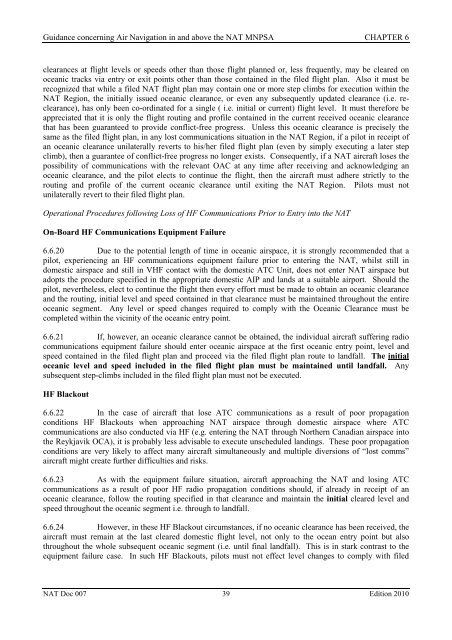World Air Ops | NAT | Doc 007 MNPS Guidance
World Air Ops | NAT | Doc 007 MNPS Guidance
World Air Ops | NAT | Doc 007 MNPS Guidance
Create successful ePaper yourself
Turn your PDF publications into a flip-book with our unique Google optimized e-Paper software.
<strong>Guidance</strong> concerning <strong>Air</strong> Navigation in and above the <strong>NAT</strong> <strong>MNPS</strong>A CHAPTER 6clearances at flight levels or speeds other than those flight planned or, less frequently, may be cleared onoceanic tracks via entry or exit points other than those contained in the filed flight plan. Also it must berecognized that while a filed <strong>NAT</strong> flight plan may contain one or more step climbs for execution within the<strong>NAT</strong> Region, the initially issued oceanic clearance, or even any subsequently updated clearance (i.e. reclearance),has only been co-ordinated for a single ( i.e. initial or current) flight level. It must therefore beappreciated that it is only the flight routing and profile contained in the current received oceanic clearancethat has been guaranteed to provide conflict-free progress. Unless this oceanic clearance is precisely thesame as the filed flight plan, in any lost communications situation in the <strong>NAT</strong> Region, if a pilot in receipt ofan oceanic clearance unilaterally reverts to his/her filed flight plan (even by simply executing a later stepclimb), then a guarantee of conflict-free progress no longer exists. Consequently, if a <strong>NAT</strong> aircraft loses thepossibility of communications with the relevant OAC at any time after receiving and acknowledging anoceanic clearance, and the pilot elects to continue the flight, then the aircraft must adhere strictly to therouting and profile of the current oceanic clearance until exiting the <strong>NAT</strong> Region. Pilots must notunilaterally revert to their filed flight plan.Operational Procedures following Loss of HF Communications Prior to Entry into the <strong>NAT</strong>On-Board HF Communications Equipment Failure6.6.20 Due to the potential length of time in oceanic airspace, it is strongly recommended that apilot, experiencing an HF communications equipment failure prior to entering the <strong>NAT</strong>, whilst still indomestic airspace and still in VHF contact with the domestic ATC Unit, does not enter <strong>NAT</strong> airspace butadopts the procedure specified in the appropriate domestic AIP and lands at a suitable airport. Should thepilot, nevertheless, elect to continue the flight then every effort must be made to obtain an oceanic clearanceand the routing, initial level and speed contained in that clearance must be maintained throughout the entireoceanic segment. Any level or speed changes required to comply with the Oceanic Clearance must becompleted within the vicinity of the oceanic entry point.6.6.21 If, however, an oceanic clearance cannot be obtained, the individual aircraft suffering radiocommunications equipment failure should enter oceanic airspace at the first oceanic entry point, level andspeed contained in the filed flight plan and proceed via the filed flight plan route to landfall. The initialoceanic level and speed included in the filed flight plan must be maintained until landfall. Anysubsequent step-climbs included in the filed flight plan must not be executed.HF Blackout6.6.22 In the case of aircraft that lose ATC communications as a result of poor propagationconditions HF Blackouts when approaching <strong>NAT</strong> airspace through domestic airspace where ATCcommunications are also conducted via HF (e.g. entering the <strong>NAT</strong> through Northern Canadian airspace intothe Reykjavik OCA), it is probably less advisable to execute unscheduled landings. These poor propagationconditions are very likely to affect many aircraft simultaneously and multiple diversions of “lost comms”aircraft might create further difficulties and risks.6.6.23 As with the equipment failure situation, aircraft approaching the <strong>NAT</strong> and losing ATCcommunications as a result of poor HF radio propagation conditions should, if already in receipt of anoceanic clearance, follow the routing specified in that clearance and maintain the initial cleared level andspeed throughout the oceanic segment i.e. through to landfall.6.6.24 However, in these HF Blackout circumstances, if no oceanic clearance has been received, theaircraft must remain at the last cleared domestic flight level, not only to the ocean entry point but alsothroughout the whole subsequent oceanic segment (i.e. until final landfall). This is in stark contrast to theequipment failure case. In such HF Blackouts, pilots must not effect level changes to comply with filed<strong>NAT</strong> <strong>Doc</strong> <strong>007</strong> 39 Edition 2010
















